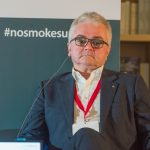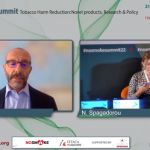In theory, policies are based on facts and values, but they also must take into consideration governance, culture, pre-existing frameworks etc. Regarding scientific issues, successful engagement in “evidence-based policymaking” requires pragmatism that must be combined with data and persuasion to translate complex scientific evidence into simple stories.
How does this work at the level of European Union? To maximize the use of scientific evidence in health and public health policy making, what is important for researchers to do? How should scientists act when they defend the creation of a policy? How does this apply to Tobacco Harm Reduction? Is there a tendency of policymakers to base judgements on their familiarity or knowledge or conceptions with the issue? There is a need for long-term strategies. What is the balance when “policies” are in the making? Are policies value-driven or evidence-based driven? What is “compelling evidence” for politicians? The panel engaged in this discussion attempted to showcase the spectrum of many nuances involved.
The moderator Natassa Spagadorou, Journalist, Greece, opened the panel discussion by sharing some thoughts about tobacco use, and by pointing out that, although policies are based in facts and values, we need policies with a human face and not with penalty- or punishment-focused.
Maria Spyraki, MEP, Greece, is a member of BECA, an ad hoc committee of the European Parliament focused on fighting cancer. In 2020, 2.7 million people in the EU were diagnosed with cancer, and another 1.3 million lost their lives to cancer, including over 2,000 young people. If we do not act now, cancer cases are going to increase by 24% by 2035. More than 40% of cancers are preventable and smoking is the number one cause of cancer. However, smoking is still here, as part of our everyday life.
According to WHO, all forms of tobacco are harmful. There is no safe level of exposure to tobacco. There is also a social dimension, as over 80% of the world’s 1.3 million tobacco users live in low- and middle-income countries. According to WHO, tobacco use contributes to poverty by diverting household spending from basic needs to tobacco. In fact, the economic cost of tobacco use includes high healthcare costs for treating the diseases that are due to tobacco and lost human capital resulting from tobacco-attributed mortality.
The EU has been intensively working on tobacco control, starting with the BECA plan to address the tobacco epidemic, Mrs Spyraki underlined. Europe’s beating cancer plan put forward actions from 2021 to help to create finally a tobacco-free generation, setting a very ambitious goal: less than 5% of the population using tobacco by 2040, compare to today’s average which is around 25%.
Additionally, the European Parliament is trying to facilitate heavy smokers to proceed to smoking cessation by using novel products, which are under strict regulation, taking into consideration that electronic cigarettes could allow some smokers to progressively quit smoking, but also that these cigarettes should not be attractive to minors and non-smokers.
Moreover, by 2023 the Commission will propose to update the cancer recommendation on smoke-free environments, by extending the implementation of its regulation to e-cigarettes and heated tobacco products and by expanding smoke-free environments, particularly including outdoor spaces.
In conclusion, Mrs Spyraki said, if we want to finally have a smoke-free environment, we must be much more proactive and creative. Tobacco advertising banning and taxes are solutions coming from the past. We must rethink the way we approach the issue of campaigns and the way we approach novel products in order to facilitate heavy smokers. We have to act together, to create an ecosystem in which the stakeholders, the production, the civil society and patients are working together, in order first to facilitate heavy smokers to quit and secondly to create a European model in which smoking is outdated.
Zoi-Dorothea Pana, MD, Cyprus, being a “hybrid” scientist due to her double role as a physician and as an advisor at the Ministry of Health of Cyprus, pointed out that maybe now is the right moment to talk about tobacco harm reduction and tobacco control, because we could leverage the existing clinical research infrastructure that we have created for the COVID-19 pandemic, and expand this infrastructure beyond the COVID-19 pandemic, for other urgent and huge public health issues. Smoking can be seen as a pandemic, if we take into account that it causes more than 8 million deaths globally every year, which is about 1/3 of the mortality that is associated with COVID.
So, we have to deal with a pandemic situation and if we want to assess the public health impact of tobacco use, we have also to discuss about chronic illnesses, multidisciplinary approaches and pragmatic approaches, Dr. Pana said. Of course, we need evidence-based medicine and real-world data but, on the other hand, as we have learned from the COVID pandemic, we also need realistic and pragmatic approaches. We need to combine these two pillars. And when we discuss about public health policies or strategies, we need to see it as a continuum.
Have we been efficient with the smoking cessation strategies that we have adopted? According to data, only 7-10% of active smokers really manage to quit smoking, which means that we need to improve our strategies and to be pragmatic.
We could also gain some knowledge from the COVID-19 pandemic and the difficulties we had to persuade the public about the vaccines. As Dr. Pana pointed out, the most appropriate way to analyze and, most importantly, to communicate harm reduction or risk assessment is to discuss about risk-benefit analysis. If we really have a more holistic approach and see the strategy as a continuum, then we could not neglect the current evidence that we have on hand, but we also need to collaborate and have coordinated, harmonized actions in order to accelerate our knowledge.
Professor Andrzej Fal, Poland, begun his speech with the remark that we tend to talk more about deaths and diseases caused by tobacco use and less about harm reduction. We all know that we shouldn’t smoke, drink or use sugar and salt, but we do not live in an ideal world. In this wrongly explained lifestyle, we have a good message coming: we do have harm reduction techniques. These include smoking and we have many facts now that show that harm reduction really works. Some people would say that we need more evidence. But we cannot have real-life evidence if we do not introduce these harm reduction techniques widely, because only after a certain time we will see the real-life data.
There are three categories of people involved in the process of policy building: researchers, physicians and politicians. Researchers, according to Mr. Fal, “are the happiest ones”, because they make a hypothesis, they do research and they either prove the hypothesis or not, but they do not have to make any policy. Physicians have a more complicated task, as they cannot use any available product on their patient, Prof. Fal explained. They need evidence-based medicines, and they can only use proven methods and approved drugs. However, physicians are also responsible for the clinical verification of what the researcher previously verified. Politicians, on the other hand―he said―cannot build evidence-based policies. They have to consider budgets and the money to be spent, and they only have a narrow window of planning of 4 years, before next elections. So, only those in Parliament can really develop health policies, not the government.
Harm reduction is something that 20 or 15 years ago was present only in the setting of drug abuse. Now, we have several classes of harm reduction, e.g., in cigarette smokers, or heavy drinkers. It is a strategy already developed in the past. Let’s stand for it.
Professor Giuseppe Biondi Zoccai, Italy, pointed out that we should examine the kind of evidence we have, because some evidence is short-term, and some evidence comes from the novel smoking products industry. There are many people who are strongly against modified risk products and we need to convince them. Another problem is that we see these modified risk products as an alternative to smoking or to nicotine replacement therapy, although it would be more reasonable to consider them as an additional tool.
The elephant in the room is the risk of creating a new generation of people addicted to modified risk products, the speaker said. We need to be aware of that because it is the main drawback of any activity promoting the use of modified risk products in risk reduction strategies.
According to Prof. Biondi Zoccai, we should act now, based on the evidence that is currently available, because if we wait, we will not be able to make immediate key decisions. However, we need several types of studies now and in the future: epidemiological studies to monitor the risk of addiction in non-smokers, especially in teenagers; randomized studies, to test the safety and efficacy of modified risk products in apparently healthy individuals, as well as in patients with advanced cardiac or pulmonary or vascular disease; and also in the future, in the “un-rosy” scenario that we have people addicted to modified risk products, we need studies to test ways to discontinue these products in these individuals.






